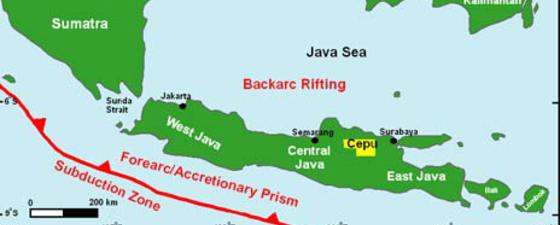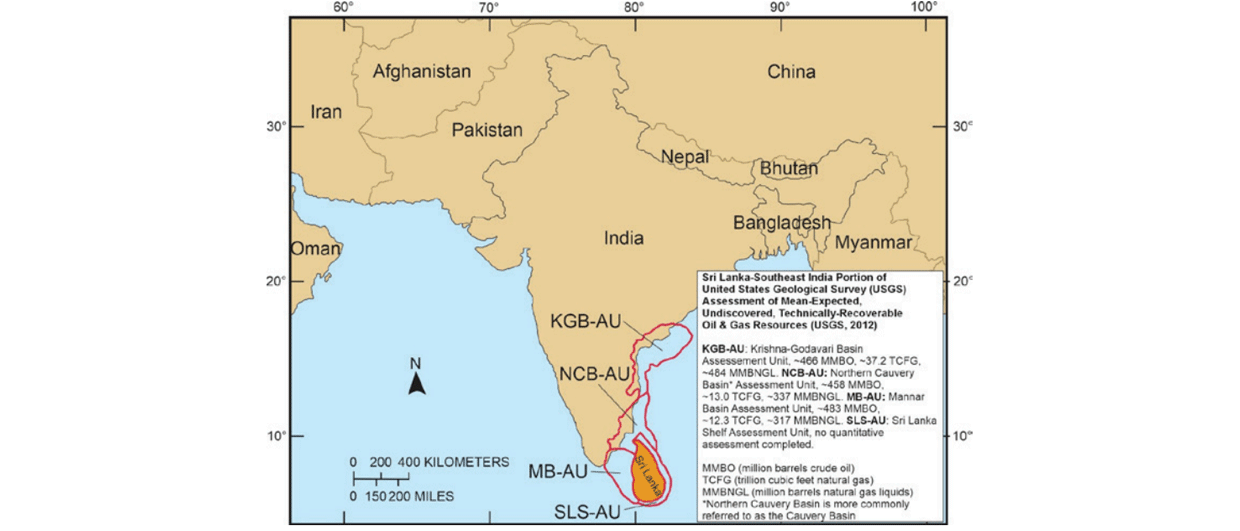The Cepu oil-and-gas block on Java Island is one of Indonesia’s major discoveries and developments in recent years, but its story reveals both potentials and problems in exploration and production activities in this South Asian country, and will draw more attention as it gains a full-scale production.
Oil is not new to the Cepu area, located about 550 km east of Jakarta (Indonesia’s capital) and 150 km east of Samarang (the capital of Central Java province). From the 1890s until the 1980s, 27 oil fields were discovered, produced and abandoned in the area. So it was considered a mature, overused basin until February 2001 when Mobil Cepu Ltd., a local subsidiary of ExxonMobil and a collaborator with Indonesia’s state oil company Pertamina, discovered the Banyu Urip Field (discovery well Banyu Urip #3 at a depth of 1737 m).
The concession for the Cepu block was first granted in 1990 to Australian Ampolex and Indonesian Humpuss Patragas (a company headed by Tommy Suharto, the youngest son of Indonesia’s former dictator). After years of unsuccessful exploration, ExxonMobil purchased the rights to the Cepu field in 1998 (the same year Exxon and Mobil merged), and utilized high resolution 3-D seismic for subsurface mapping. The discovery well tested oil at a rate of 3,817 barrels per day (bpd) from the Middle Miocene carbonate Kujung Formation, and 463 bpd from the overlying Ngrayong sandstone member. Both ExxonMobil and Petramina were excited of this discovery. “The discovery in the BU-3 well is one of the most significant oil findings in Indonesia in the past decade,” Pertamina said in a press release (Jakarta Post, 13 April 2001).
But shortly after, problems surfaced. ExxonMobil and Pertamina became engaged in years-long negotiation and competition over share and operation. In 2006, the newly elected President Susilo Bambang Yudhoyono decided to fire Pertamina’s board, and pick ExxonMobil as the main operator. A 30-year producing sharing contract signed by ExxonMobil and Pertamina in that year gave each party 45% share, and the remaining 10% went to the four local governments in East and Central Java (distributed 6.7% and 3.3%, respectively). Field development was estimated to cost $2.7 billion.
Although Java is mainly a Cenozoic volcanic island formed from the subduction of the Australian plate beneath the Asian plate, its sedimentary basins have been shaped by back-arc rifting and compressional folding, and its equatorial position has resulted in excellent carbonate reef reservoirs. The classic Kujung carbonates show porosity of 20-30% and permeability of up to 200 millidarcy (locally enhanced by fracturing). Source rocks for the Kujung pools are probably the Eocene-age shale and coal deposits of Ngimbang Formation, and the shale beds of the Miocene Tuban Formation have acted as top seals.
In December 2008, test production from Cepu’s main Banyu Urip field began with six wells (including two water-gas re-injection wells) and at a rate of 800 bpd (the production capacity was reported to be 20,000 bpd in April this year). Nonetheless, the field’s development and production schedule have been delayed due to logistic hurdles including problems in construction of a pipeline to flow oil to a nearby gas-oil separation plant, now under construction. Furthermore, to develop the field, ExxonMobil’s land men had to negotiate with 3,000 landowners who owned 4,000 plots (each plot in the area is about one hectare on average).
Both Indonesia and ExxonMobil consider the Cepu block a huge opportunity. It has been reported as one of ExxonMobil’s top 10 projects worldwide. Indonesia is eager to bring Cepu on full stream as it is struggling to boost its oil and gas production and to attract foreign investments (partly because of complex regulations and logistics). Although it ranks as the world’s 25th and 10th in terms of oil and gas reserves, respectively, Indonesia’s production has significantly decreased over the years (from 1.5 MMbpd in the 1990s to 0.83 MMbpd early this year) as many of its fields have aged. In fact, in 2008 the country had to quit OPEC as it had become a net importer of crude oil since 2003. The Cepu block (including the Banyu Urip and Jambaran fields) is expected to produce 16,500 to 18,000 bpd by 2012. The block is estimated to contain up to 600 million barrels (6.7% of Indonesia’s total known reserves) and 1.7 Tcf of natural gas. Java’s gas fields usually contain up to 5% carbon dioxide; the Jambaran field has been reported to contain as much as 30% carbon dioxide, whose separation will add to production costs.
Reelection of the open market-friendly President Yudhoyono this past July will perhaps boost Indonesia’s petroleum industry and investments, including the development of the Cepu block, a surprising but rewarding discovery in a mature basin.





